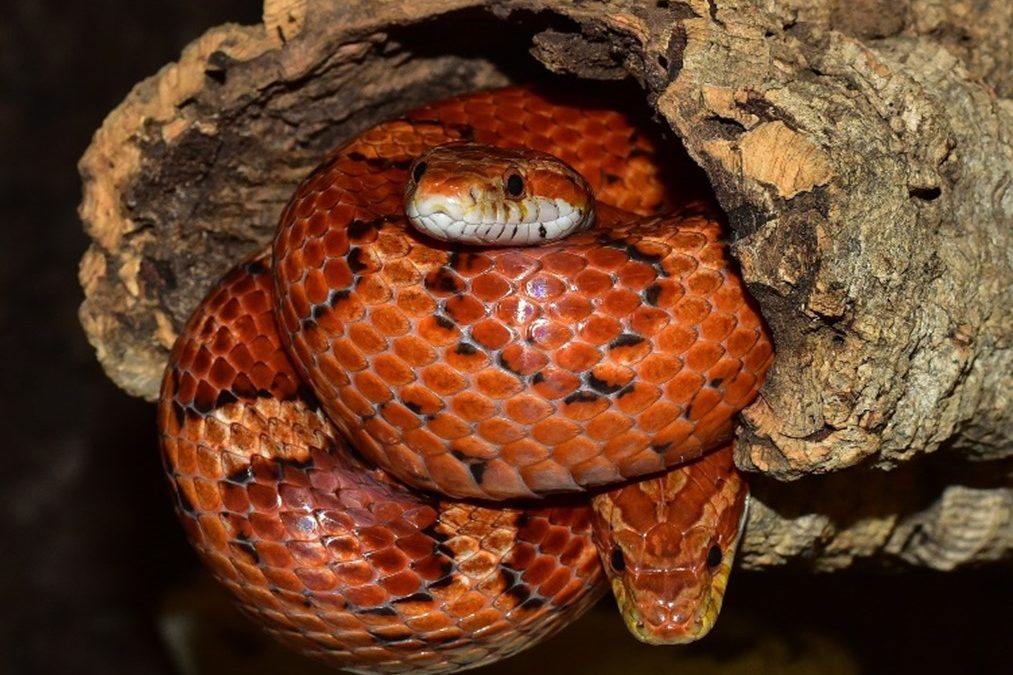Caging
In the wild, corn snakes prefer staying in overgrown fields, forest openings, trees, and even abandoned buildings and farms. This gives them plenty of room and space to hide as they live near their prey – rodents. If you want to own a corn snake, you must first consider if you have the capacity to build and maintain a good home for your soon-to-be pet.
Baby corn snakes can live in a small plastic vivarium the size of a large shoebox. However, when they grow into adults they need a 20-gallon long aquarium at the very least. Check if you have that much space in your home before anything else.
Make sure to provide some dark hiding spaces for your snake to help them feel secure, and some branches for them to climb. Fill the tank with plants and boxes to hide in. Snakes may get traumatized when they can’t hide, so give them room and accessories to feel secure. Privacy is as important to a snake as it is to us. Use rocks and treated wood available in pet stores.
Only one corn snake should stay in a cage as they get stressed easily. While they are docile, they are not exactly friendly to other animals. Make sure that their cages are inescapable, as snakes with their long bodies can easily get through small openings. Not exercising caution and failing to check the cage will not end well for both you and your corn snake. It is best to use a mesh lid so the tank will have enough ventilation.
Lighting and Temperature
Natural light from windows will let your corn snake adjust its day and night cycles as well as its seasonal cycles. However, be careful to keep their cage away from direct sunlight as the temperature may become lethal for your corn snake.
Use a temperature gradient with a light or under tank heat pad or cable. Your snake tank should have a warm zone and a cool zone, with a hiding area in each zone. 85 degrees Fahrenheit is a good warm temperature while around 70 degrees Fahrenheit is a good cool temperature. While your local pet shop may suggest getting heat rocks, using heat rocks is not recommended. Snakes have sensitive skin and are prone to burns.
Use a long, skinny hiding place for your snake: a hollow log or PVC pipe. Keep one end cool and the other end warm. This keeps the temperature at a comfortable level for your corn snake. When checking the temperature, check inside the warm end of the hide and not on the glass as the temperature may be different.
Increase the humidity inside the hide box by adding a clump of damp moss or paper towel if your snake prepares to shed. Remember to remove it between sheds to avoid having unwanted bacteria, mold, and more.
Bedding
Breeders often use aspen shavings because it is absorbent, soft, and it holds its shape when snakes burrow. You may also use Cypress mulch, but avoid aromatic woods like pine or cedar because the oils can be toxic to your corn snake. You can also opt for newspaper and reptile carpet; however, corn snakes get under it when they can. Do not use ‘reptile sand’ – it may cause impactions your snake ingests it.
Cleaning
At the very least, one must do a thorough cage cleaning once a month to keep the cage free from bacteria which may be harmful to your corn snake. Besides doing full cleanings, you must also spot clean the cage when you have to – cleaning the water bowls weekly, removing feces and shed skin, and more.
Before doing a full cleanse of your corn snake’s cage, you must first find a suitable temporary cage for your snake. Check for components you need to clean and replace such as the bedding of the cage. After doing these, you may start cleaning by following these steps:
- Gather your cleaning materials. Paper towels, spray disinfectant, water sprayer, trash bag, and other materials you think will come in handy.
- Relocate your corn snake to a temporary cage. A medium-sized Rubbermaid box with a lockable lid and air holes will do.
- Remove all the cage furniture items and decorations such as bowls, hides, branches, rocks, plants, and place them in the bathtub or sink.
- Unplug all the electrical devices on the cage such as heating and lighting.
- Remove old substrate. If your bedding of choice is shavings or something similar, dump the cage or use a vacuum.
- Clean the empty cage. Use a spray bottle with water and paper towels to clear the dust, feces, and other dirt. Afterwards, use an antibacterial disinfectant.
- Leave the cage open so it can finish drying completely while you clean the other items.
- Clean the cage items with antibacterial soap and hot water. You may soak some items overnight in a diluted bleach solution (One part bleach to four parts water) if you have difficulty getting the dirt out.
- Make sure to clean the water bowl thoroughly with antibacterial soap and hot water. Rinse with hot water.
- Do not scrub plastic bowls with fingernails or scouring pads. It will leave scratches on the bowl and it will make it harder to clean in the future. Instead, use the smooth part of your finger to rub the bowl clean, or soak it overnight.
- Add new bedding and replace the cage furniture. Fill up the bowl with fresh water.
- Put your snake back in and plug in the electrical devices. Make sure all the locks and latches are secure.






 Author and long-time animal lover. Sharing knowledge on pet care through experience and the written word.
Author and long-time animal lover. Sharing knowledge on pet care through experience and the written word.